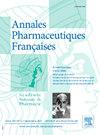Antioxidant potential and phytochemical constituents of a synergy-based combined extract of Spondias mombin L., Spilanthes filicaulis (Schumach. & Thonn.) C.D.Adams and Piper guineense Thonn
IF 1
Q4 PHARMACOLOGY & PHARMACY
引用次数: 0
Abstract
Objective
Recent advancements in scientific understanding of free radicals have stimulated progress in medicine. Antioxidants are known to neutralize free radicals by giving up electrons. The current research was carried out to explore the antioxidant capabilities and phytochemical composition of a synergy-based combined extracts of Spondias mombin, Spilanthes filicaulis, and Piper guineense, with the goal to determine the optimal ratio for the most effective antioxidant activity, suitable for herbal product development.
Material and methods
Combined extracts H1 and H2 were obtained through aqueous maceration of S. mombin leaves, S. filicaulis plants, and P. guineense fruits. Antioxidant activity of combined extract was evaluated in 2, 2-diphenyl-1-picrylhydrazyl (DPPH) and ferric ion reducing power (FRAP) assay. Evaluations included total phenolic and flavonoid content determination. Furthermore, the phytochemical constituents were determined using Gas Chromatography-Mass Spectrometry (GC-MS).
Results
The combined extract H1 exhibited better free radical scavenging ability in DPPH (IC50 = 72.87 ± 0.63 μg/mL) than H2 (IC50 = 150.2 ± 1.08 μg/mL). The FRAP assay results revealed its highest reducing power (12.385 ± 0.002 AAE/mg/g) compared to H2 (11.657 ± 0.002 AAE/mg/g). Additionally, H1 had higher of both total phenolic and flavonoid content. GC-MS profiling revealed 28 compounds within H1 and 17 compounds within H2.
Conclusion
This study demonstrated that the combined extract H1 has significant antioxidant potential, with consistently positive results across all conducted assays. It contains a variety of phytochemical constituents, mainly phenolic and flavonoids that could be explored in pharmaceutical industries to develop antioxidant agents.
Objectif
Les nouvelles connaissances scientifiques sur les radicaux libres ont stimulé les progrès en médecine. Les antioxydants sont connus pour neutraliser les radicaux libres en cédant des électrons. La présente recherche vise à explorer les capacités antioxydantes et la composition phytochimique d’extraits combinés synergiques de Spondias mombin, Spilanthes filicaulis et Piper guineense, dans le but de déterminer le ratio optimal pour une activité antioxydante maximale, adapté au développement de produits à base de plantes.
Matériels et méthodes
Les extraits combinés H1 et H2 ont été obtenus par macération aqueuse des feuilles de S. mombin, des plantes entières de S. filicaulis et des fruits de P. guineense. L’activité antioxydante de l’extrait combiné a été évaluée par les tests DPPH (2,2-diphényl-1-picrylhydrazyle) et FRAP (pouvoir réducteur des ions ferriques). Les teneurs totales en phénols et en flavonoïdes ont également été déterminées. De plus, la composition phytochimique a été analysée par chromatographie en phase gazeuse couplée à la spectrométrie de masse (CG-SM).
Résultats
L’extrait combiné H1 a montré une meilleure capacité de piégeage des radicaux libres dans le test DPPH (IC50 = 72,87 ± 0,63 μg/mL) que H2 (IC50 = 150,2 ± 1,08 μg/mL). Les résultats du test FRAP ont révélé son pouvoir réducteur le plus élevé (12,385 ± 0,002 AAE/mg/g) par rapport à H2 (11,657 ± 0,002 AAE/mg/g). De plus, H1 présentait des teneurs totales en phénols et en flavonoïdes supérieures. Le profilage par CG-SM a révélé 28 composés dans H1 et 17 composés dans H2.
Conclusion
Cette étude a démontré que l’extrait combiné H1 possède un potentiel antioxydant significatif, avec des résultats constamment positifs dans tous les essais réalisés. Il contient une variété de composés phytochimiques, principalement des phénols et des flavonoïdes, qui pourraient être explorés dans les industries pharmaceutiques pour développer des agents antioxydants.
基于协同作用的 Spondias mombin L.、Spilanthes filicaulis (Schumach. & Thonn.) C.D.Adams 和 Piper guineense Thonn.
目的:近年来,科学界对自由基的认识不断提高,推动了医学的进步。众所周知,抗氧化剂可以通过放弃电子来中和自由基。目前的研究旨在探索 Spondias mombin、Spilanthes filicaulis 和 Piper guineense 联合提取物的抗氧化能力和植物化学成分,目的是确定最有效抗氧化活性的最佳比例,以适合草药产品的开发:综合提取物 H1 和 H2 是通过水浸泡 S. mombin 叶片、S. filicaulis 植物和 P. guineense 果实获得的。用 2, 2 - 二苯基-1-苦基肼(DPPH)和铁离子还原力(FRAP)测定法评估了组合提取物的抗氧化活性。评估包括总酚和类黄酮含量的测定。此外,还使用气相色谱-质谱法(GC-MS)测定了植物化学成分:综合提取物 H1 的 DPPH 自由基清除能力(IC50 = 72.87 ± 0.63 µg/mL)优于 H2(IC50 = 150.2 ± 1.08 µg/mL)。FRAP 检测结果显示,与 H2(11.657±0.002 AAE/mg/g)相比,H1 的还原力最高(12.385±0.002 AAE/mg/g)。此外,H1 的总酚和类黄酮含量都较高。GC-MS 图谱显示,H1 中有 28 种化合物,H2 中有 17 种化合物:这项研究表明,综合提取物 H1 具有显著的抗氧化潜力,在所有测试中都取得了一致的积极结果。它含有多种植物化学成分,主要是酚类和黄酮类化合物,可用于制药业开发抗氧化剂。
本文章由计算机程序翻译,如有差异,请以英文原文为准。
求助全文
约1分钟内获得全文
求助全文
来源期刊

Annales pharmaceutiques francaises
PHARMACOLOGY & PHARMACY-
CiteScore
1.70
自引率
7.70%
发文量
98
期刊介绍:
This journal proposes a scientific information validated and indexed to be informed about the last research works in all the domains interesting the pharmacy. The original works, general reviews, the focusing, the brief notes, subjected by the best academics and the professionals, propose a synthetic approach of the last progress accomplished in the concerned sectors. The thematic Sessions and the – life of the Academy – resume the communications which, presented in front of the national Academy of pharmacy, are in the heart of the current events.
 求助内容:
求助内容: 应助结果提醒方式:
应助结果提醒方式:


